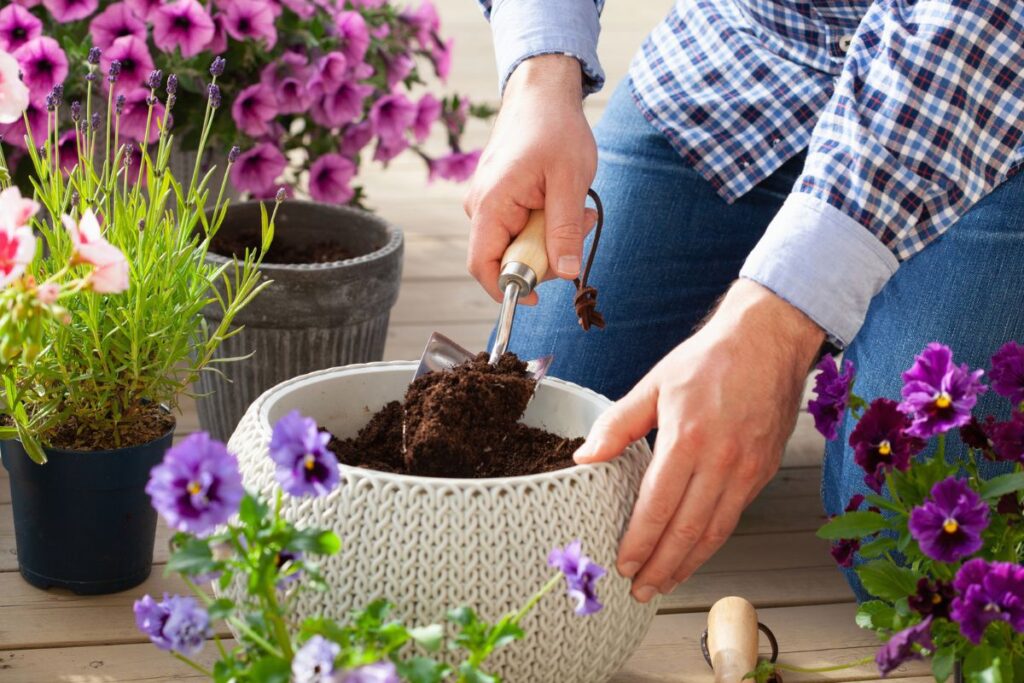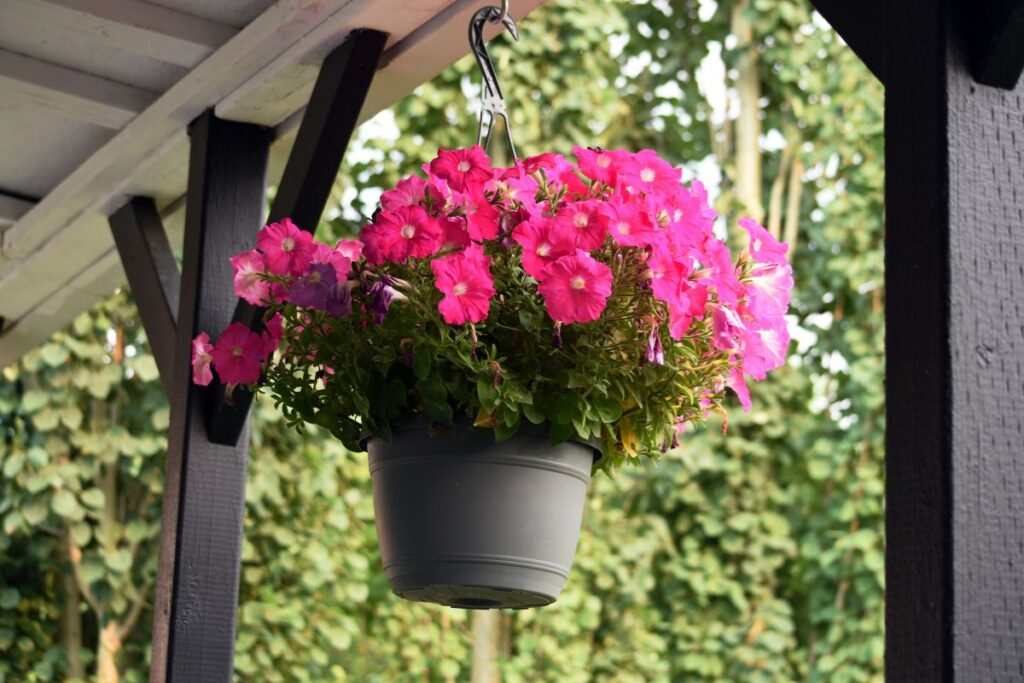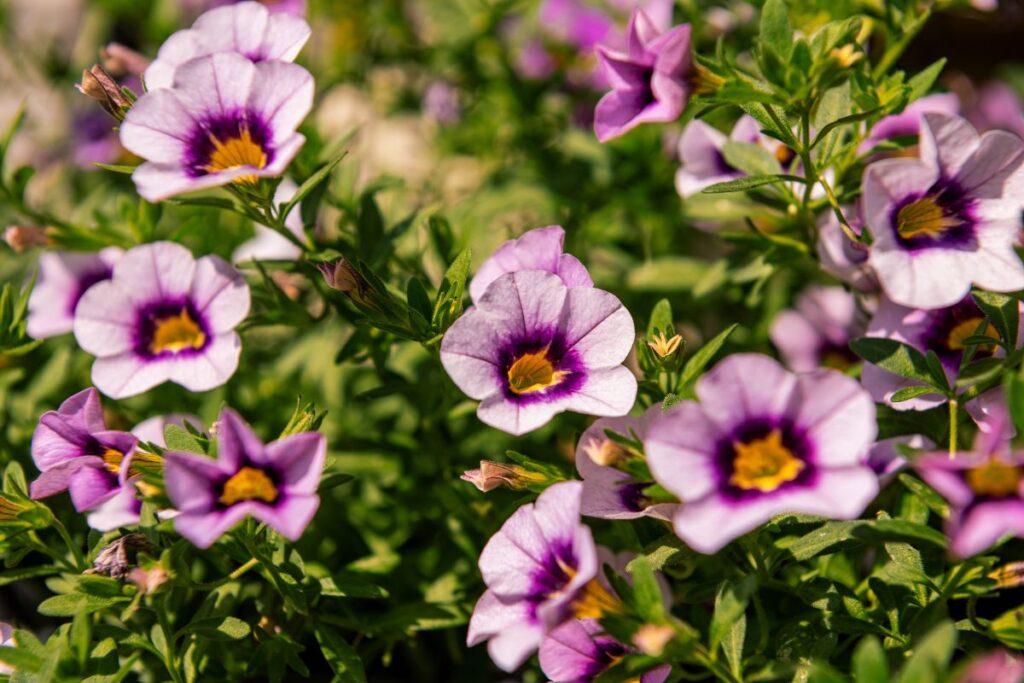Dreaming of vibrant hanging baskets filled with petunias?
Growing and caring for them is easier than you think.
Learn the best tips and tricks to make your petunias flourish.
Ready to beautify your space?
Let’s get started!
Growing Beautiful Petunias in Hangers
Petunias are a top choice for attracting hummingbirds and butterflies, making them ideal for pollinator gardens. But what’s the secret to growing them successfully in hanging planters?
To thrive in hanging baskets, start by selecting the right variety of petunias, choose an appropriate pot, use well-draining potting soil, and plant them carefully. We’ll also cover tips for overwintering these lovely flowers, so be sure to read on!
Selecting the Right Petunia Types
Look at how petunias grow when choosing the right one. Some kinds are hardy in zones 10-11, and you can grow them as annuals or perennials depending on where you live. Most petunias need lots of sunlight, but some can handle light shade. Pick a type that suits your lighting situation.
Wave Petunias
Wave petunias spread easily and bloom all summer long. They don’t require deadheading because they clean themselves. These are usually annuals but can be perennials in zone 11.
Supertunias
Supertunias form mounds and look gorgeous in hanging baskets. They’re great for summer parties and flourish in warm climates. These petunias are hardy, colorful, and resistant to diseases.
Choosing an Ideal Planter
Pick a hanging basket with at least one drainage hole to prevent overwatering. Terracotta pots are great for drainage, while plastic ones hold more water. Iron pots can heat up too much in the summer.
If you can’t find a suitable pot, you can make a DIY hanging planter at home using ropes.
Prepping the Potting Soil
Petunias need well-draining soil, so avoid using garden dirt. Ready-made potting mixes are ideal because they offer good aeration. You can prepare your own mix using native soil, compost, vermiculite or perlite, and peat moss.
Add some slow-release fertilizer to the soil before planting your petunias.
Steps to Plant Petunias
Plant petunias in late spring or early summer. They’re sensitive to cold, so keep them inside if it’s still chilly.
Fill your hanging basket with the prepared soil mix, place your petunia plants in it, and add more soil on top. Water the basket until the excess drains out.
Depending on the variety and pot size, you may plant multiple petunias per basket. Keep shaded types 5-6 inches apart, while full-sun types need a foot of space.
Overwintering Your Petunias
To avoid replanting each year, bring your hanging baskets indoors to a bright spot where they’ll keep growing. Alternatively, induce dormancy by placing them in a cool, low-light area like a garage. Keep them away from frost and not in complete darkness.
The plant will start growing again when spring arrives.
6 Tips for Caring for Petunias in Hanging Baskets
If you’re familiar with the care guide for black magic petunias or any other variety, you can easily apply that knowledge to growing petunias in hanging baskets. While the pruning requirements may vary slightly, petunias typically need full sun, well-draining soil, and regular watering, especially during hot summer days.
We’ll dive into these care tips in more detail in the following sections, so you can beautifully adorn your patio with these vibrant flowers!
Sunlight Needs for Petunias
Petunias flourish in bright, direct sunlight. Full sun exposure is ideal for the most vibrant blossoms. While some varieties can handle a bit of shade, this might cause the plants to grow leggy, leading to extra pruning during the hotter months.
Proper Watering and Humidity Levels
Petunias in hanging baskets or containers tend to dry out quicker than those in the ground. This means you need to water them more often, especially during hot and dry weather, when they might need watering twice daily.
To determine if your petunias need water, check the soil. If it feels dry and light, it’s time to water. Continue watering until you see water draining from the bottom of the basket.
Petunias thrive in areas with low humidity, making them suitable for dryer climates. If you live in a more humid region, space the plants out to ensure good airflow and reduce the frequency of watering. Always inspect the topsoil before watering to avoid over-watering.
Temperature Preferences
Petunias love warm weather, with daytime temperatures between 60-80°F being perfect. They prefer slightly cooler nights, around 55-65°F. These plants aren’t cold-hardy and will suffer if temperatures drop below 40°F. To keep them thriving through the winter, bring them indoors to protect them from the cold.
Soil and Nutrient Requirements
Petunias need a well-draining, fertile growing medium with a neutral pH. You can make this by combining garden soil with compost or organic matter and some perlite for better drainage.
When planting petunias, use a slow-release fertilizer to provide a steady nutrient supply. For abundant blooms, add a water-soluble fertilizer rich in phosphorus and potassium before the flowering period. While not essential, fertilizers help maintain vibrant, healthy plants and knowing the difference between compost and fertilizer can help you decide which nutrient source is best for your garden.
How to Propagate Petunias
You can propagate petunias from seeds or cuttings, depending on your patience and plant needs. Cuttings will clone the mother plant, which is useful if you have a stunning petunia you want to replicate.
Propagating from Cuttings
- Pick healthy stems and cut them just below a leaf node. Remove the flowers and lower leaves.
- Dip the cut ends in rooting hormone and plant them in a seed-starting mix, keeping each cutting an inch apart unless using a divided nursery tray.
- Water thoroughly and maintain constant moisture. Cover with a humidity dome or plastic bag to increase humidity.
- Place in a location with indirect light and maintain room temperature for optimal growth.
- Look for new growth to confirm rooting. Gently pull the cutting to check for resistance, indicating root development.
- Leave young plants in the nursery tray for several weeks, then transfer them to larger containers.
Planting from Seeds
Growing petunias from seeds is even more straightforward. Plant seeds in damp seed-starting mix, cover lightly with soil, and keep at room temperature. They don’t need light to germinate.
Within a week, the seeds will sprout. Gradually increase light exposure as they grow. Keep the soil moist during this period. Once the seedlings have a few true leaves, they’re ready to be transplanted into larger containers.
Pruning for Optimal Growth
Regular pruning significantly benefits petunias, especially in mid-summer. It’s best to prune three times during the summer months, starting in early July. Focus on trimming the leggy parts and aim to remove about 1/3 of the plant each time. Repeat this process in mid-August and mid-September for healthier, more vigorous plants.
Best Companions for Petunias
You can grow multiple petunias in a large hanging basket and even pair them with other perennials like geraniums, hydrangeas, and calibrachoa.
For a meaningful display, consider plants that symbolize hope and serenity.
Watch out for pests like aphids, mealybugs, and spider mites. Use ladybugs or horticultural oils to manage infestations promptly.
Geranium
Geraniums make excellent partners for petunias in hanging baskets. Their taller stature provides texture and dimension to your garden.
These plants flourish in full sun and require well-drained, fertile soil, making their care straightforward. Picture tall geraniums at the center with cascading petunias along the sides of the planter. This combination creates an outstanding visual effect.
Calibrachoa
Calibrachoa looks similar to petunias but features smaller blossoms, offering a pleasant contrast in your basket.
Both petunias and calibrachoa share similar pruning and care needs. This simplifies garden maintenance. Since petunias grow more vigorously, planting more calibrachoas and fewer supertunias maintains a balanced flower arrangement.
Hydrangea Cuttings
Combining petunias and hydrangeas might seem unusual, yet they make a distinctive display that will impress visitors. Both plants thrive under similar conditions and can even start together in the same nursery tray.
Picture petunias’ cascades accentuating the voluminous hydrangea blooms from the sides of your planter. This pairing highlights each plant’s unique beauty.
Common Pests
Monitor for aphids, mealybugs, and spider mites on all these plants. Quick intervention with ladybugs or horticultural oils can help manage infestations.
- Plant resistant varieties when possible.
- Regularly inspect leaves and stems for early signs.
- Favor organic solutions to keep your plants healthy.
Using these tips, you can coordinate your petunias with geraniums, calibrachoa, and hydrangea cuttings for an enchanting garden display.
The best results, grow them outdoors during warmer seasons and move them inside during the winter.
Conclusion
Growing petunias in hanging baskets is simple and adds a significant touch of elegance to your outdoor space. Opt for a variety that blooms abundantly, and use a basket with proper drainage to avoid waterlogging. Plant your petunia in soil that drains well.
Ensure they get plenty of sunlight. Water them when the topsoil is dry, and feed them now and then to maximize the blooms.
Consider pairing supertunias or wave petunias with hydrangeas, geraniums, or calibrachoa for a unique display. These combinations can make your garden stand out.
Enjoy your vibrant petunia blooms! If you found this helpful, feel free to share or pin it for later!





